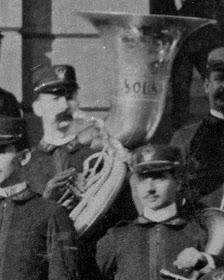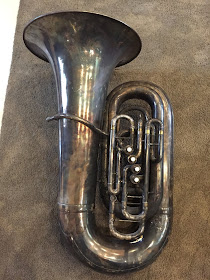 |
| Conrad with a monster helicon in Gilmore's Band, 1889 |
We don't know much about this horn, and I have yet to find one that has survived the ravages of time, but it had a 21 inch bell, "celebrated French piston valves and improved light action," and sat very strangely below the left shoulder (notice in the photo above, which is how it looks in every photo I have found of it being held; frankly, I'm baffled!). According to a Lyon & Healy catalogue from 1880 - eight years before Conrad started playing it - the helicon sold for $330, which translates to about $11,400 today. So I would imagine it was a pretty decent horn.
Conrad appears to have used this massive helicon for all five years he played with Gilmore's Band (1888-1892), as well as the first three years he was with Sousa's Band (1893-1895). But Sousa was not a fan of helicons, so he had J. W. Pepper modify a helicon into what became known as a "Sousaphone." In 1896, the Sousa Band went on tour with the very first one:
 |
| With the very first Sousaphone, built by J. W. Pepper in 1895 |
Just how long this new instrument was played by Conrad in Sousa's Band is uncertain, but in early 1898 we see him playing a completely different Sousaphone - the first one built by C. G. Conn:
 |
| With Conn's first Sousaphone for Sousa's Band, 1898 |
The second Sousaphone built by Conn, which came out barely a year later, was purchased by Joseph Dupere, who was not connected with Sousa's Band. He allegedly paid $250 for the horn, which is around $8,300 today, or, interestingly, about what a Conn Sousaphone sells for now.
By 1900 we find that the Conn Sousaphone played by Conrad had been modified into what we will refer to as version 2:
 |
| With Conn's second version of his Sousaphone for Sousa's Band, 1900 |
 |
| With Conn's third version of his Sousaphone for Sousa's Band, 1903 |
Conrad played this horn with Sousa until he left the band in late 1903 to join Arthur Pryor's new band and, shortly after that, to become part of the newly formed Victor Orchestra, which served as the "house band" for the Victor Talking Machine Company. Here is what might be a photo of him with Pryor in 1904 (it does look a bit like him, but we can't be sure):
 |
| With what appears to be a CC Sander rotary-valve tuba in Pryor's Band, 1904 |
 |
| Sam Gnagey's CC Sander - possibly the very same tuba |
However, Sam has another photo of this horn from the early 1900s, and it is being held by someone who is definitely not Conrad. Sam understands it to be Fred Geib, who, incidentally, was subbing in the Philadelphia Orchestra from 1904-05, while C. Stanley Mackey was touring Britain with Sousa's Band (Mackey played tuba with the Philadelphia Orchestra from its founding in 1900 until his death in 1915 - with the exception of his brief stint with Sousa). So, it may very well be Geib, rather than Conrad, in the photo above. We just can't say for sure.
But what we can say is that Sam's CC Sander tuba has a 16 inch diameter bell, a .807 inch bore, a weight of only 14 pounds, and a height of 35 inches. He describes the sound as "rather dark but with a good focus and core."
This is the only rotary-valve tuba connected with Conrad at this point. He seems to have preferred front action piston valves, as we shall see, which is one more reason to question that it is Conrad in the photo above.
By 1912 Conrad can be seen playing a unique Holton Mammoth BBb Bass:
 |
| With a custom Holton Mammoth BBb tuba at Victor, 1912 |
Tubist and collector Mike Lynch owns what appears to be this exact horn:
 |
| Mike Lynch's BBb Holton - possibly the very same tuba |
 |
| With an unknown BBb recording bell tuba at Victor, 1913 |
At first glance, it looks very much like a Conn 48j CC "New Wonder" Phonograph Model, although that horn came along later, as far as I can tell. But according to master tuba technician Matt Walters, there are enough differences to suggest that it was perhaps another Holton, and more likely a small BBb horn.
 |
| With another (custom?) BBb Holton tuba at Victor, 1918 |